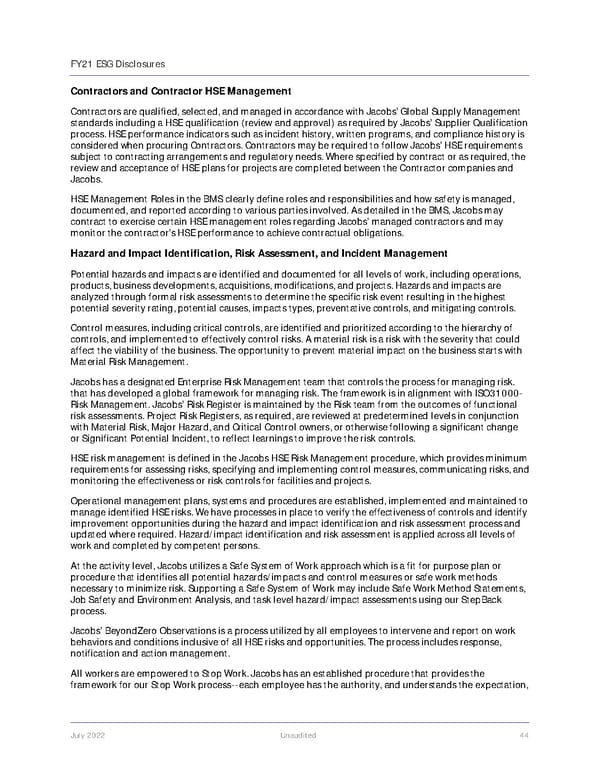FY21 ESG Disclosures July 2022 Unaudited 44 Contractors and Contractor HSE Management Contractors are qualified, selected, and managed in accordance with Jacobs’ Global Supply Management standards including a HSE qualification (review and approval) as required by Jacobs’ Supplier Qualification process. HSE performance indicators such as incident history, written programs, and compliance history is considered when procuring Contractors. Contractors may be required to follow Jacobs’ HSE requirements subject to contracting arrangements and regulatory needs. Where specified by contract or as required, the review and acceptance of HSE plans for projects are completed between the Contractor companies and Jacobs. HSE Management Roles in the BMS clearly define roles and responsibilities and how safety is managed, documented, and reported according to various parties involved. As detailed in the BMS, Jacobs may contract to exercise certain HSE management roles regarding Jacobs’ managed contractors and may monitor the contractor’s HSE performance to achieve contractual obligations. Hazard and Impact Identification, Risk Assessment, and Incident Management Potential hazards and impacts are identified and documented for all levels of work, including operations, products, business developments, acquisitions, modifications, and projects. Hazards and impacts are analyzed through formal risk assessments to determine the specific risk event resulting in the highest potential severity rating, potential causes, impacts types, preventative controls, and mitigating controls. Control measures, including critical controls, are identified and prioritized according to the hierarchy of controls, and implemented to effectively control risks. A material risk is a risk with the severity that could affect the viability of the business. The opportunity to prevent material impact on the business starts with Material Risk Management. Jacobs has a designated Enterprise Risk Management team that controls the process for managing risk. that has developed a global framework for managing risk. The framework is in alignment with ISO31000- Risk Management. Jacobs’ Risk Register is maintained by the Risk team from the outcomes of functional risk assessments. Project Risk Registers, as required, are reviewed at predetermined levels in conjunction with Material Risk, Major Hazard, and Critical Control owners, or otherwise following a significant change or Significant Potential Incident, to reflect learnings to improve the risk controls. HSE risk management is defined in the Jacobs HSE Risk Management procedure, which provides minimum requirements for assessing risks, specifying and implementing control measures, communicating risks, and monitoring the effectiveness or risk controls for facilities and projects. Operational management plans, systems and procedures are established, implemented and maintained to manage identified HSE risks. We have processes in place to verify the effectiveness of controls and identify improvement opportunities during the hazard and impact identification and risk assessment process and updated where required. Hazard/impact identification and risk assessment is applied across all levels of work and completed by competent persons. At the activity level, Jacobs utilizes a Safe System of Work approach which is a fit for purpose plan or procedure that identifies all potential hazards/impacts and control measures or safe work methods necessary to minimize risk. Supporting a Safe System of Work may include Safe Work Method Statements, Job Safety and Environment Analysis, and task level hazard/impact assessments using our StepBack process. Jacobs’ BeyondZero Observations is a process utilized by all employees to intervene and report on work behaviors and conditions inclusive of all HSE risks and opportunities. The process includes response, notification and action management. All workers are empowered to Stop Work. Jacobs has an established procedure that provides the framework for our Stop Work process--each employee has the authority, and understands the expectation,
 Jacobs Engineering Group ESG Disclosures Page 44 Page 46
Jacobs Engineering Group ESG Disclosures Page 44 Page 46